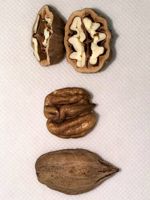Mon-Fri 9am - 5pm Mountain time
Black Locust vs Burton Hican
Robinia pseudoacacia
Carya ovata x illinoinensis Burton
NOT AVAILABLE THIS SEASON - MIGHT RETURN
Black Locust is an attractive tree. Its distinctive leaves are made of about a dozen bright green leaflets. It also notable for its fragrant white flowers, which smell of citrus.
Black Locust can grow in many situations, but prefers dry areas with lots of sun. It is robust and is an excellent choice for establishing shade in dry, open areas.
Important note: Much of the Black Locust is toxic to humans and livestock, including seeds, bark, and leaves.
Burton Hican is a rare cross between Shagbark Hickory and Pecan. Most Hickory x Pecan hybrids are not reliable producers but the Burton Hican produces large crops annually (in warmer climates). The medium sized nuts fall in between the Pecan and Hickory and are known for having a great flavor. They are well suited to fresh eating, cooking, and baking with a good storage life.
Hicans will carry features from both species. The Hickory influence causes earlier ripening times while the taste and productivity come from the Pecan. The Pecan genetics also cause the nuts to have a thinner shell that is easier to crack and the pecan-like shape makes kernel removal easier.
The Burton Hican is generally considered self pollinating but having a second variety for cross pollination will increase nut production. They have been known to cross pollinate with other Hicans, Shagbark Hickory, and some Pecans. Nut production is expected after 7-10 years.
Note: Plant this tree once. Due to its large tap root transplanting is not recommended.

